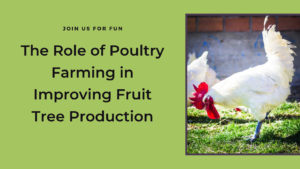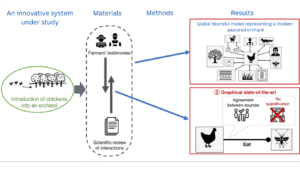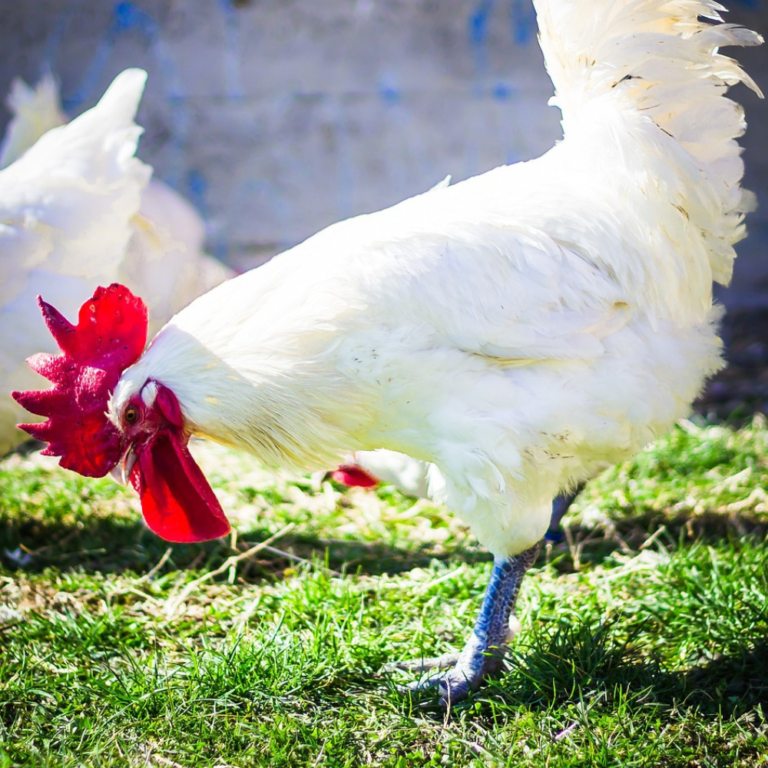
Integrating poultry farming with fruit tree production is a sustainable practice that enhances both the health of your orchard and the productivity of your poultry. This symbiotic relationship benefits soil fertility, pest control, and overall tree health, making it a highly recommended strategy for small and large-scale farmers.
By allowing chickens, ducks, or other poultry to roam in the orchard, you create an ecosystem that supports natural fertilization, pest management, and soil improvement. Here’s how poultry farming plays a crucial role in boosting fruit tree production.
Nutrient Enrichment Through Poultry Manure
One of the primary advantages of poultry farming is the natural enrichment of the soil through poultry manure. Poultry manure is rich in essential nutrients like nitrogen, phosphorus, and potassium, which are vital for healthy fruit tree growth. Unlike synthetic fertilizers, this natural manure slowly releases nutrients into the soil, promoting long-term soil fertility and improving the nutritional uptake of fruit trees.
According to Sustainable Agriculture Net, poultry manure is one of the most nutrient-dense organic fertilizers available, enhancing soil structure and fostering the growth of strong, resilient trees.
Natural Pest Control
Another major benefit of integrating poultry in your orchard is the role they play in natural pest control. Chickens and ducks are natural foragers, eating pests such as insects, larvae, and slugs, which can otherwise harm your fruit trees. This reduces the need for chemical pesticides, making your orchard more organic and eco-friendly.
By adopting permaculture principles in farming, you can achieve a balanced ecosystem in your orchard where the poultry helps control pest populations naturally. As explained by Permaculture Principles, a balanced ecosystem reduces your reliance on external inputs, such as chemical treatments, leading to a more sustainable farming practice.
Chickens and ducks are excellent at controlling pests like insects and slugs, reducing the need for chemical pesticides. This natural pest control makes your orchard more organic and less reliant on harmful chemicals. In addition, their foraging behavior helps control weeds, minimizing competition for water and nutrients. As discussed in growing sunflowers, certain plants can also act as natural barriers or pest deterrents, complementing the poultry’s role in the orchard.
Weed Management
In addition to pest control, poultry help manage weeds in your orchard. As they forage for insects, they naturally scratch the soil, reducing weed populations. This helps to lower the competition for water and nutrients between fruit trees and weeds. Weed control also ensures that the fruit trees can maximize their growth potential and produce higher yields.

Soil Aeration
Poultry naturally scratch the ground while foraging, which helps improve soil aeration. This process loosens compacted soil, allowing better water absorption and air circulation for fruit tree roots. Improved soil aeration promotes healthier root growth and enhances the overall structure of the soil, creating optimal growing conditions for fruit trees.
Proper soil aeration is particularly important in orchards with heavy, clay-rich soils that are prone to compaction. By improving the soil’s structure, you enable the fruit trees to absorb nutrients and water more efficiently, which leads to better yields.
Challenges in Combining Poultry and Fruit Trees
While there are numerous benefits to combining poultry farming with fruit trees, there are some challenges to consider:
- Overgrazing: If the poultry population is too high, it can lead to overgrazing, which may damage young fruit trees or expose roots.
- Manure toxicity: Over-application of poultry manure can lead to a buildup of toxic levels of nitrogen, which can harm trees and the surrounding ecosystem.
To avoid these issues, it’s essential to monitor the number of poultry in your orchard and rotate them to different areas regularly.
Best Practices for Integration
Successfully integrating poultry into your orchard requires careful planning. Here are some best practices to follow:
- Rotational Grazing: Use mobile coops or rotational grazing techniques to prevent overgrazing and ensure that manure is evenly distributed.
- Tree Protection: Protect the base of young trees with fencing or tree guards to prevent damage from foraging poultry.
- Even Distribution of Manure: Spread the manure in controlled amounts to avoid nutrient buildup that could damage your fruit trees.
By implementing these strategies, you can enjoy the benefits of poultry farming while minimizing risks.
Economic Benefits of Poultry-Orchard Integration
In addition to improving fruit tree production, combining poultry farming with your orchard can lead to significant economic benefits:
- Reduced input costs: By relying on natural fertilization and pest control from your poultry, you can reduce the need for chemical fertilizers and pesticides.
- Additional income streams: Poultry farming can provide additional income through the sale of eggs, meat, or even manure as compost. This diversification can make your farming operation more resilient and profitable.
Environmental Impact and Sustainability
Integrating poultry farming with fruit tree cultivation promotes sustainable agriculture. By reducing the need for synthetic chemicals, you protect the environment and enhance the biodiversity of your farm. The combination of organic pest control, natural fertilization, and soil improvement supports healthier ecosystems and makes your orchard more resilient to climate challenges.
FAQs About Poultry Farming in Orchards
- Can chickens damage fruit tree roots?
Chickens can potentially damage young fruit tree roots through over-scratching. It’s best to use tree guards or fencing for young trees. - How do I prevent poultry from overgrazing in my orchard?
Implement rotational grazing and ensure you don’t overcrowd the orchard with too many birds. Mobile coops can help distribute their impact. - What types of fruit trees benefit the most from poultry farming?
Most fruit trees, including apple, pear, and stone fruit trees, benefit from poultry integration, but it’s essential to manage the number of birds to prevent overgrazing. - How often should I rotate poultry through the orchard?
Rotating every 1-2 weeks ensures that the birds don’t overgraze and that manure is spread evenly. - What is the ideal number of chickens per acre in an orchard?
For most orchards, 50 chickens per acre is a good number, depending on the density of trees and the age of the orchard.
Conclusion
The role of poultry farming in improving fruit tree production cannot be understated. By integrating poultry with orchards, farmers can achieve a sustainable, cost-effective solution that boosts soil fertility, reduces pests, and enhances overall tree health. When managed properly, the relationship between poultry and fruit trees can be highly beneficial for both the environment and the farmer’s bottom line.
By using these natural methods, you’re supporting sustainable farming practices and fostering a more balanced ecosystem that benefits not only your farm but the surrounding environment as well.
Relevant Anchor Text and Links
- Sustainable Agriculture Net – Learn more about the benefits of organic poultry farming.
- Permaculture Principles – Discover how permaculture can enhance your farming practices.
